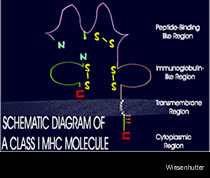U.C.L.A. Rheumatology Pathophysiology of Disease Course Lecture,
Second Year Medical School 1997
3. There is a strong suggestion that the genetic make-up of the individual strongly influences the likelihood of developing each of these diseases.
The genetic factors are different for each disease. However the onset of the disease is controlled by an as yet undetermined interplay between the genetic make-up of the individual and unknown causes in the environment which may have to be present to provoke the disease. Only a small minority of people with a susceptible genetic background will develop clinical features of these diseases (figure 2).
The most common arthritis in man, however, is osteoarthritis (OA). This is a process in which the cartilage pads between the bones begins to wear (figure 3-4). Genetic factors contribute to the underlying strength of the cartilage, and environmental factors, especially whether injuries have occurred, play a major role in determining the degree of OA in an individual at any given age. There is not likely to be much involvement of the immune system in this process, and inflammation is present only to a minimal extent and is generally a result of mechanical wear. In fact, osteoarthritis is a normal accompaniment of aging, with about 85% of 55 year old men having xray detectable OA. It is only when the process reaches a marked degree of severity, effects a weight bearing joint (hip, knee), or a joint required for

Figure 2. The HLA molecules that one inherits determines in part the susceptibility to autoimmune disease. Both class I and class II HLA molecules have an intracellular, transmembrane, and extracellular portion. The extracellular portion of the HLA molecules combine with peptides stemming from the breakdown of antigenic proteins. 210 x 178 pixels 11kbs